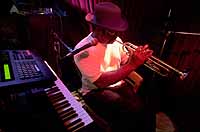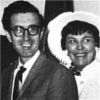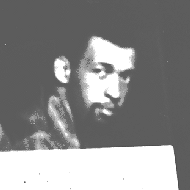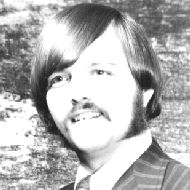 |
By Nikki Boertman Thirty-three years after a plane crash killed singer Otis Redding and four members of the Bar-Kays, surviving bandmate Ben Cauley performs as a one-man band as well as with other groups and on other artists' albums. |
INDEX -- NEWS -- INFOS -- STAX TODAY -- FOCUS -- ADS -- LISTS -- LINKS -- PHOTOS -- CONTACT
STAX
NEWS
page
9
ABOUT
BEN CAULEY AND OTIS' PLANE CRASH
(december
4th, 2000)
'67 crash turned ex-Bar-Kay Cauley into one-man band
 |
By Nikki Boertman Thirty-three years after a plane crash killed singer Otis Redding and four members of the Bar-Kays, surviving bandmate Ben Cauley performs as a one-man band as well as with other groups and on other artists' albums. |
By
Tom Bailey Jr.
The Commercial Appeal
Moist-mouthed travelers devouring barbecue at Da' Blues Memphis far down Memphis International's Concourse B don't fathom what they are seeing and hearing. If they understood, some might become moist-eyed when the one-man band in the corner sings the late Otis Redding's classic, Dock of the Bay. Musician Ben Cauley slips discs of his prerecorded instrumental accompaniment into the disc player, pounds his electronic keyboard, blows his trumpet, sings smoothly and gently, and graciously acknowledges the smattering of applause, often led by the bartender. But Cauley, 53, doesn't tell the restaurant crowd who he is.
The businessman screens himself behind a newspaper, the young couple chatter, a woman speaks on the cell phone, and a man at the bar stares at his beer. They have no idea this lone performer was the lone survivor on Dec. 10, 1967, the day so much music died.
Sunday at 3:28 p.m. will mark the 33rd anniversary of the airplane crash that killed Redding, his pilot, his valet, and four of the five members of the Bar-Kays aboard. Of the eight people riding in the twin-engine Beechcraft, only Cauley survived. Killed were Redding, pilot Richard Fraser, valet Matt Kelly, and Bar-Kays Phalon Jones, saxophone; Carl Cunningham, drums; Jimmy King, guitar; and Ronnie Caldwell, keyboards. The plane plummeted into Lake Monona near Madison, Wis., on a Sunday afternoon.
The weekend had started with Redding flying to Memphis to pick up the Bar-Kays at Memphis Aero late the previous Friday afternoon. They performed for Vanderbilt students in Nashville Friday night. They played in Cleveland Saturday night. On no more than an hour or two of sleep, the musicians climbed into the frigid plane cabin at the Cleveland airport between 5:30 and 6 that Sunday morning, Cauley recalls. "Carl asked an attendant at the airport to crank it up" so the cabin could warm up, he said. "But the attendant told us he couldn't crank it up because the battery was sort of low. He said he'd rather have Dick (the pilot) crank it up." Upon hearing the battery needed charging, Cauley and Cunningham looked at each other. Still, the plane took off without incident. They would fly all day to Madison, where they would play that night at a nightclub called The Factory. Redding sat in the co-pilot's seat. Cauley sat directly behind Redding facing the rear. The passengers started the flight in conversation. "We were talking about Little Richard, Sam Cooke, Wilson Pickett. Otis said his favorite artists were Little Richard and Sam Cooke," Cauley said. Redding also talked enthusiastically about a song he wrote and had recorded a few days before, Dock of the Bay. (The song would be released about a month after his death and become Redding's first No. 1 hit.) Gradually, one by one, the passengers fell asleep. The plane was about 3 minutes from landing in Madison.
A severe shaking of the aircraft woke Cauley up. His first thought was heavy turbulence. "But I remember Phalon got up and looked out the window. "I remember him saying, `Oh, nooo.' " "I said, `What are you talking about?' " As he asked the question, Cauley unbuckled his seat belt. The plane hit the water at a 35-degree angle before Jones could respond. Neither Redding nor the pilot said a word in the seconds Cauley was awake before the crash. The next thing Cauley recalls is being in the water. He's sure he blacked out for a few moments, probably brought back to consciousness by the near-freezing lake. "I remember thinking, `We're in the wrong place.' " But he had the right thing in his grasp: a seat cushion. It kept him afloat. "Where it came from, I can't say. But I lost it, and another (cushion) came to me." It took emergency crews only 17 minutes to reach the crash site by boat. Meanwhile, Cauley remembers seeing two others alive in the water. Cunningham surfaced for a moment without speaking. Caldwell yelled "Help!". "I said, `Hold on, man, hold on.' But Cauley couldn't reach him in time. Cauley received relatively minor injuries, a bump above the forehead and a cut on his left foot. But he was unaware the others were dead. His rescuers made him lie down on the shore, told him not to get up and that the others were OK. Cauley remembers the coroner visiting him in his hospital room. " `You're lucky,' he said. "He turned away and then turned back toward me and said, `You're the only one alive.' "Cauley said the information put him in shock, and that he could not talk for hours.
He returned home a few days later. He re-formed the Bar-Kays with another surviving member who had taken a commercial flight from Cleveland to Madison, bass guitarist James Alexander. But Cauley left the group in 1971 to strike out on his own. He has experienced varying degrees of success, working solo and with other groups, playing for others' albums.
Disaster struck
again on Aug. 25, 1989, when he suffered a massive stroke.
Doctors didn't expect him to live. He proved them wrong. Doctors
also "told him he'd never be able to play trumpet again,"
said Cauley's wife, Shirley. But he relearned how to walk, talk
and even play the horn. He writes music, performs solo and with
groups, plays for parties and records in his own tiny but well-equipped
studio at home. On its walls hang two large photographs of the
Bar-Kays, one including Redding. His only regularly scheduled
performances occur at Da' Blues Memphis. He's there Mondays and
Fridays 11:30 a.m. to 1 p.m. and 7 to 8:30 p.m., and Tuesdays,
Wednesdays, Thursdays and Sundays from 7 to 8:30 p.m. One
business traveler gave Cauley his rapt attention. Max Magnabosco
of Indianapolis smiled and nodded with the beat as Cauley sang
and played. "His horn-playing is marvelous," Magnabosco
said as he headed out to catch a connection to New Orleans. Told
what Cauley had experienced 33 years ago, Magnabosco paused,
looked up and said, "I'm shocked to find that out. "They
should have his name up there. Who is this guy?
Such a great player." Cauley said he believes Redding and
his friends died for a cause: the love of music. He's often asked
himself why he was spared. He's not sure he knows the answer, but
Cauley knows this much: ``If I can help somebody, that's what I
want to do."
Thanks
to Cherrie Holden for sending this very interesting article.
ABOUT
JIM STEWART AND ESTELLE AXTON
(october
30th, 2000)

I received the
following message from my friend Derrald Leo Mote in LA. Here is
what he said:
"Another
item I've noticed just now: I was scrolling thru the Rock and
Roll Hall of Fame <www.rockhall.com> and the National
Academy of Recording Arts and Sciences <www.grammy.org> webpages... Did you notice the absence
of Stewart and Axton's names, in contrast to that rival sole
owner of "that hit-making label in Detroit" --as its
competitor-- without a award? Stewart and Axton have NOT been
inducted in the Rock and Roll Hall of Fame yet, nor received a
Grammy (Lifetime Achievement or Trustee's) award, in contrast to
the other record label moguls did.
Personally, I find this very irritating. Here's an idea: Make a
notice to loyal fanatics to the Stax Site about the non-existence
of Stewart & Axton about putting out a petition to have them
earn thier place in both awards, because it has been 40+ years
that the twosome haven't got their props yet.
NARAS e-mail: webmaster@grammy.org (or go to its webpage as
listed).
For Rock and Roll Hall of Fame inductees, no e-mail exists. Snail
mail to:
Rock and Roll Hall of Fame Foundation
1290 Ave. of the Americas
New York, NY 10104, USA.
It would be a blessing for these wonderful music excutives from
the deep south in times, while racial segration was at its
paramount, to get what they deserve."
I agree with you
Derrald. Let's do it, now!
MORE
NEWS FROM JOE SHAMWELL
(october 25th,
2000)

Joe Shamwell
today
Ex Stax hit composer Joe Shamwell (see underneath) has sent me some more details about himself:
* I was the "Joe"
of Barbara & Joe (Respect).
* Janet Jackson recorded "What'll I Do For Satisfaction",
which was written by me and Steve Cropper for Johnny Daye. It
appeared on her "Janet" LP (1993).
* I am currently finishing touches on the writing of a major
musical with Broadway potential.
* William Bell and I spoke today. We are going to
collaborate very soon (within the next month) on new material.
* I am writing and producing two songs for a new Peaches &
Herb project.
* Robert Cray recorded " Got To Make A Comeback" (originally
done by Eddie Floyd) on his "Bad Influence" LP.
* In Jackson, MS in the '60's thru the '80's, I was known on the
air as the "Soul Ranger". In 1998, I received a
Distinguished R&B Radio Legend award at the 24th Annual
Jackson Music Awards.
* In my current position with ABC Radio in Washington, DC, I am
on the leading edge of where the marketing radio is going,
including internet partnership. I constantly interact with every
major advertiser in the DC area.
THE
MYSTERY IS SOLVED!
(october 24th,
2000)

For years, I had
been wondering who was the man appearing at the back of the Stax
studio, behind Isaac Hayes and David Porter on a promo photo,
taken in the second part of the 60s. Thanks to the magic of the
Internet, the mystery is finally solved. The mysterious Stax man
is Joe Shamwell. Here is the message he has just sent to me:
"That mystery man is me! I was a songwriter at
Stax who collaborated with many Stax writers including Isaac
& David, Booker T, Eddie Floyd, Steve Cropper, William Bell,
Mack Rice and others. I was born and raised in Washington, DC. As
a youngster, I was regularly in and out of my cousin Charles'
home at 1212 T Street (where years earlier Duke Ellington was
raised). I later worked at Waxie Maxie's Record Store at 7th
& T Sts., where I met Eddie Floyd and began songwriting. In
1967, I headed for Memphis, TN, where I joined the famed
Stax/Volt Record label and wrote songs with and for Carla Thomas
and her father Rufus, Eddie Floyd, Isaac Hayes, The Bar-Kays,
William Bell, Con-Funk-Shun, Booker T & The MG's, Johnnie
Taylor and others. After Stax closed its doors in the mid '70's,
I moved to Jackson, MS, where I became a major radio personality
and wrote songs for such blues greats as Bobby "Blue"
Bland, Z.Z. Hill, Little Milton, Robert Cray and Deniece LaSalle.
In the '90's, my work took on a life of its own. Major
artists such as Janet Jackson began finding my songs and
recording them, and my work was featured in TV in shows like
"Matlock", "21 Jump Street" and "L.A.
Law". One song, "I'm A Blues Man" is currently
featured in the hit Broadway musical, "It Ain't Nothing But
The Blues".
Joe
Shamwell
Director, Marketing Research
ABC Radio Washington
Thank you very
much, Joe and keep on the good work.
GOOD
AND BAD NEWS ABOUT DON COVAY
(october 18th,
2000)

Friend Derrald Leo
Mote from California reports that Don Covay was on CNN's World
Beat programme some days ago. He received an award for the Rhythm
& Blues Foundation's Pioneer Award. He appeared in a
wheelchair whilst the reporter mentioned that he had suffered a
stroke. Then again, he was interviewed. No slurred speech overall.
Way to go Don!
MEMORIES
FROM RON GORDEN
(october 17th,
2000)

Ex Bar-Kays'
keyboardist Ron Gorden then Stax Advertising Manager has sent me
very rare Stax artifacts and photos, to be found on this site. He
was also kind enough to share some interesting memories with me:
"Think
of me as just a small character in the epic story called Stax. I
joined the Bar-Kays in February, 1968, as organ player when the
band was first reorganized following the December 10, 1967, plane
crash that killed Otis Redding and four members of the Bar-Kays.
A friend told me they were reorganizing, and an audition was
arranged.
As a
member of the Bar-Kays I toured most of North America and played
in all sorts of places, many of which were famous and many were
obscure. We appeared in stadiums and coliseums, popular
nightclubs, college campuses, and well-known music venues like
San Francisco's Fillmore West and New York's Village Gate. We
often shared the stage with other well-known performers; in
addition to most of the Stax roster of artists we worked with
superstars such as Jimi Hendrix, Joe Tex, B.B.King, Sly & the
Family Stone, Pigmeat Markham, the Association, Chicago, Janis
Joplin, and the Monkees, to name a few.
As a
member of the Bar-Kays, I was in and around Stax almost
continuously when we were not traveling. We recorded there. We
sometimes rehearsed there. Often I just visited the studio to see
what interesting things were going on.
Doing
recording sessions in the Stax studios was very enjoyable and
thrilling to me. I was fortunate enough to participate in a
several recording sessions for other artists at Stax. I had more
strength as an entertainer (on stage) than as a studio player,
and I knew that at the time and made no pretenses otherwise. When
I was not traveling with the band, it was normal for me to spend
time at the studio watching, learning, or just visiting. No one
ever made me feel unwelcome, I guess because I was accepted as a
Stax artist.
My
most important contribution to Stax was in the advertising
department. When the time came for me to leave the Bar-Kays, it
did not immediately occur to me to work at the record company. My
college major and my chosen future was the advertising business.
Stax was the music business. I applied at every advertising
agency in Memphis. I tried every venue I could think of to get
into the advertising profession. I remember even applying to
Musak, the elevator music company, to see if I could help develop
and market their music product. The answer was always the same -
I did not have any experience.
As almost a last result I went to see Deanie Parker, the director
of publicity for Stax. She told me that she did not have a job
for me, but arranged an introduction to Larry Shaw, Stax’s
brand new advertising manager at the new corporate offices on
North Avalon.
I
resigned the Bar-Kays in early 1970 and began working in the
newly formed advertising department. My first title was humorous
to me: "Assistant Traffic Coordinator." It was my job
to keep track of the increasing flow of projects funneling
through our two-man department, but it was my privilege and good
fortune to be associating with Larry Shaw. He was a master of
creativity and a fountain of wisdom. From him I learned about
business, about advertising, about graphic design, and about
striving for perfection. He is still one of my favorite people,
and although we rarely have contact I still consider him one of
my closest friends.
I embraced the heavy work load in the advertising department, and
promotions came rapidly. Still in my early twenties, I was never
an "executive" in the sense that I participated in
corporate decisions or strategy, but I did have a tremendous
amount of responsibility within the realm of advertising,
packaging, and support materials. It was my job to engage and
direct a large number of outside suppliers for things like
photography, art, and typesetting as well as printing, album
cover fabrication, displays, and specialties. We also reviewed
publications, both trade and consumer, to determined the best
application of our advertising funds, and prepared and placed the
ads. After Mr. Shaw became immersed in the Wattstax concert
project and became the head of the newly formed Stax Films, I was
promoted to Advertising Manager.
My work in the advertising department began in the brand new
Avalon offices, and later we moved to Union Avenue Extended.
During my tenure, I was directly responsible for coordinating the
development of over 130 album covers and the trade and consumer
advertising that accompanied those products. We were very busy
and productive, and I remember often talking on two phones at the
same time. I experienced the unbelievable prosperity of the
mushrooming company when there were no budgets and the sky was
the limit. We did great work and won numerous awards ranging from
local Memphis Advertising Federation "Addy’s" to a
Grammy Award nomination for package design ("Isaac Hayes
Live at Sahara Tahoe"). We were well thought of and
respected in all business circles. It was an unbelievable
experience!
In
only a year, however, circumstances completely changed. As we
braved the corporate "strangulation" of Stax, every
possible corner of expense had to be cut - and more. I spent much
of each day in my Union Avenue office during 1974 consoling and
encouraging suppliers who were wanting payment. We quickly became
outcasts in the community with Stax having such a stigma that,
after being laid off, I could not get a job anywhere in Memphis.
Even knowing what I know now, I would have stayed longer if
allowed. (I believe my last paycheck was part of the last regular
payroll ever paid.)".
Thanks a lot, Ron. More from him soon, I hope. Ron can be contacted at this e-mail address: rgorden@nwark.net
INDEX -- NEWS -- INFOS -- STAX TODAY -- FOCUS -- ADS -- LISTS -- LINKS -- PHOTOS -- CONTACT